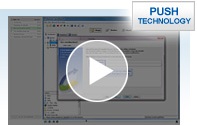|
|
|
| |
Push messages
Overview
Using Push technologies (polling and streaming) with NeoLoad requires an optional module (Push module).
When using a Push Framework, all the application updates are carried out through the Push channel, whether by polling or streaming. See Push frameworks. NeoLoad provides a mechanism to simplify the creation of Virtual User profiles so that certain actions are carried out according to the type of response received through the Push channel. Each type of response configured in NeoLoad is called a Push message.
You may only define Push messages in polling or streaming requests. See Polling requests and Streaming requests.
For more information, click the image below to see the Neotys video about Push technologies in NeoLoad:
